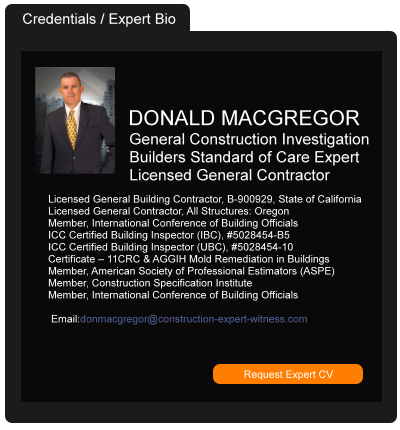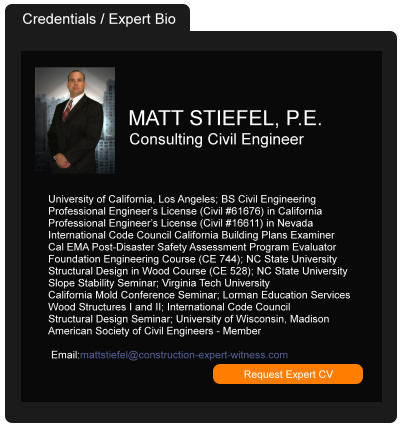Construction Defects could become Issue in Governor’s Race
October 22, 2014 —
Jesse Howard Witt – Acerbic WittAccording to today’s Denver Business Journal, construction defects have emerged as a potential issue in Colorado’s gubernatorial race. During last night’s debate, Republican challenger Bob Beauprez criticized incumbent Democrat John Hickenlooper for failing to help senators with a last-minute push to enact a bill stripping away homeowner protections in construction disputes. Republicans had argued that the bill was needed to appease apartment developers who claim that quality control and insurance costs are too high on condominium projects.
Read the court decisionRead the full story...Reprinted courtesy of
Jesse Howard Witt, The Witt Law FirmMr. Witt welcomes comments at www.wittlawfirm.net
Woodbridge II and the Nuanced Meaning of “Adverse Use” in Hostile Property Rights Cases in Colorado
November 23, 2020 —
Luke Mecklenburg - Snell & Wilmer Real Estate Litigation BlogEarlier this year, the Colorado Court of Appeals issued an opinion addressing at length “whether the requirement that the use be ‘adverse’ in the adverse possession context is coextensive with adverse use in the prescriptive easement context.” See Woodbridge Condo. Ass’n, Inc. v. Lo Viento Blanco, LLC, 2020 COA 34 (Woodbridge II), ¶ 2, cert. granted, No. 20SC292, 2020 WL 5405376 (Colo. Sept. 8, 2020). As detailed below, the Woodbridge II court concluded that the meanings of “adverse” in these two contexts are not coextensive—while “hostility” in the adverse possession context requires a claim of exclusive ownership of the property, a party claiming a prescriptive easement is only required to “show a nonpermissive or otherwise unauthorized use of property that interfered with the owner’s property interests.” Thus, the Woodbridge II court reasoned a claimants’ acknowledgement or recognition of an owner’s title alone is insufficient to defeat “adverse use” in the prescriptive easement context.
This significant ruling is at odds with a prior division’s broad statement, while considering a prescriptive easement claim, that “[i]n general, when an adverse occupier acknowledges or recognizes the title of the owner during the occupant’s claimed prescriptive period, the occupant interrupts the prescriptive use.” See Trask v. Nozisko, 134 P.3d 544, 553 (Colo. App. 2006). Perhaps for that reason, Woodbridge II is currently pending certiorari review before the Colorado Supreme Court in a case that should provide some much-needed clarity on what constitutes “adverse use” in the context of a prescriptive easement. As we await the Colorado Supreme Court’s decision, I thought it worthwhile to provide a brief analysis of the Woodbridge II court’s deep dive into the nuances of “adverse use” in this field of Colorado law.
Read the court decisionRead the full story...Reprinted courtesy of
Luke Mecklenburg, Snell & WilmerMr. Mecklenburg may be contacted at
lmecklenburg@swlaw.com
Eleven Newmeyer Dillion Attorneys Named to 2023 U.S. News Best Lawyers in Multiple Practice Areas
August 29, 2022 —
Newmeyer DillionNEWPORT BEACH, Calif. – August 18, 2022 – Prominent business and real estate law firm Newmeyer Dillion is pleased to announce that eleven of the firm’s attorneys were recently selected for inclusion and will be recognized in their respective areas in The Best Lawyers in America© 2023.
Additionally, Greg Dillion, Thomas Newmeyer and Michael McClellan have been selected to Best Lawyers 2023 Lawyer of the Year list in Litigation - Construction, Construction Law and Litigation - Real Estate respectively.
The eleven 2023 Best Lawyers are:
Best Lawyers is the oldest peer-review publication for the legal profession. Attorneys are chosen through intensive peer-review surveys in which leading lawyers evaluate their professional peers. Best Lawyers listings are published in almost 70 countries worldwide and are recognized for their reliable and unbiased selections.
Read the court decisionRead the full story...Reprinted courtesy of
Labor Intensive
May 10, 2022 —
Neil Flynn - Construction ExecutiveIn 2020, the United States saw a significant decrease in non-fatal workplace injuries, which dropped to 2.1 million from 2.8 million the year before. While the precise extent to which this reduction in workplace injuries is attributable to COVID-19 is unknown, the pandemic was undoubtedly a significant factor. It is also unclear to what extent the pandemic affected the number and rate of workplace incidents in 2021 or might continue to do so in 2022 and beyond.
However, it is reasonable to expect that, as pandemic-related restrictions are removed and life returns to normal, the construction industry will revert to pre-pandemic employment levels and beyond. It is also reasonable to conclude that, once that level of recovery is attained, the number and rate of both fatal and non-fatal workplace incidents will increase substantially.
Even with the significant reduction in the overall number of workplace injuries in 2020, the United States still saw nearly 8,000 construction workers miss at least one day of work due to an injury sustained on the job, according to the U.S. Bureau of Labor Statistics (BLS). And, despite construction accounting for just 6% of jobs, BLS reports that construction-related incidents account for 20% of workplace deaths, or three every day. This one-fifth share of workplace fatalities makes construction the third-deadliest industry in the United States.
Reprinted courtesy of
Neil Flynn, Construction Executive, a publication of Associated Builders and Contractors. All rights reserved.
Read the court decisionRead the full story...Reprinted courtesy of
Mr. Flynn may be contacted at
nf@plattalaw.com
Force Majeure Under the Coronavirus (COVID-19) Pandemic
March 29, 2021 —
Lindsay T. Watkins - Ahlers Cressman & Sleight PLLCAs COVID-19 disrupts work and life as we know it, the question many contractors have is what protections are available against the inevitable project impacts and delays? Generally, construction contracts require a contractor to timely perform work until project completion or potentially face damages (liquidated or actual) and possible termination. When events occur, however, that are beyond our control (such as a national pandemic), it is important to review and understand what contract provisions or avenues are available for potential relief.
- Review Your Contract For A Force Majeure Provision.
A “force majeure” contract provision is commonly included in construction contracts, service agreements, purchase orders, etc. It typically covers events or conditions that can be neither anticipated nor controlled. These provisions, however, will vary greatly from contract to contract and may not include the language “force majeure” but rather may be included in general delay or impact clauses. For example, some common provisions include:
- Washington State Department of Transportation Clause (2018 Standard Specifications for Road, Bridge and Municipal Construction): The Contractor shall rebuild, repair, restore, and make good all damages to any portion of the permanent or temporary Work occurring before the Physical Completion Date and shall bear all the expense to do so, except damage to the permanent Work caused by: (a) acts of God, such as earthquake, floods, or other cataclysmic phenomenon of nature, or (b) acts of the public enemy or of governmental authorities; or (c) slides in cases where Section 2-03.3(11) is applicable; Provided, however, that these exceptions shall not apply should damages result from the Contractor’s failure to take reasonable precautions or to exercise sound engineering and construction practices in conducting the Work.
Read the court decisionRead the full story...Reprinted courtesy of
Lindsay T. Watkins, Ahlers Cressman & Sleight PLLCMs. Watkins may be contacted at
Lindsay.Watkins@acslawyers.com
OSHA Advisory Committee, Assemble!
February 06, 2023 —
Rachel E. Pelovitz - Construction ExecutiveThe Occupational Safety and Health Administration (OSHA) has sourced new members for its Advisory Committee on Construction Safety and Health, which was established by the Construction Safety Act to provide “advice and assistance in construction standards and policy matters” to the assistant secretary of labor for occupational safety and health. The committee consists of 15 members, one appointed by the secretary of labor, to represent the interests of employers, employees, state safety and health agencies, in addition to the public.
Reprinted courtesy of
Rachel E. Pelovitz, Construction Executive, a publication of Associated Builders and Contractors. All rights reserved.
Ms. Pelovitz may be contacted at pelovitz@abc.org
Read the full story... Read the court decisionRead the full story...Reprinted courtesy of
Claims Made Insurance Policies
November 04, 2019 —
David Adelstein - Florida Construction Legal Updates“Claims-made policies are common in the professional liability insurance market. They “differ from traditional ‘occurrence’-based policies primarily based upon the scope of the risk against which they insure.” With claims-made policies, coverage is provided only where the act giving rise to coverage “is discovered and brought to the attention of the insurance company during the period of the policy.” In contrast, coverage is provided under an occurrence-based policy if the act giving rise to coverage “occurred during the period of the policy, regardless of the date a claim is actually made against the insured.” “The essence, then, of a claims-made policy is notice to the carrier within the policy period.”
Crowely Maritime Corp. v. National Union Fire Ins. Co. of Pittsburgh, PA, 2019 WL 3294003 (11thCir. 2019)
The recent Eleventh Circuit Court of Appeal opinion in Crowely Maritime Corp. discussed the distinction between a claims-made insurance policy and an occurrence-based insurance policy. Professional liability policies are generally claims-made policies whereas commercial general liability policies are generally occurrence-based policies. While this opinion does not involve a construction matter, the case did concern the definition of a “claim” in a claims-made policy and whether such claim was timely reported to the insurer within the discovery period / extended reporting period.
Read the court decisionRead the full story...Reprinted courtesy of
David Adelstein, Kirwin Norris, P.A.Mr. Adelstein may be contacted at
dma@kirwinnorris.com
The Jersey Shore gets Beach Prisms Designed to Reduce Erosion
January 22, 2014 —
Beverley BevenFlorez-CDJ STAFFThirty-five beach prisms manufactured by Smith-Midland Corporation have been installed along the Jersey shore in Ocean Gate, New Jersey. According to the Wall Street Journal, “The prisms protect homes, prevent erosion, and reduce impacts from natural disasters like Hurricane Sandy.” They “are made with a built-in parabolic curve that scatters waves away as spray instead of allowing them to crash up onto the vulnerable shoreline.”
Ocean Gate’s Mayor Paul J. Kennedy stated, "We've been losing beach year after year with the Nor'easters we get. So we came up with an idea that hopefully will work,” The Wall Street Journal reported.
Read the court decisionRead the full story...Reprinted courtesy of


































































